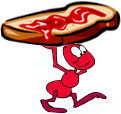As every picnicker knows, if you spill strawberry jam in the grass, it will be swarming with ants in no time at all. The ants arrive quickly because they always find the shortest route from their nests to the spill — but how? That question is one that fascinates cutting-edge engineers, computer programmers, and other scientists, who study nature in order to design better and more efficient technology — a quest compellingly described in Peter Bentley’s new book, Digital Biology.
Take the example of the ants: Everywhere an ant goes, it leaves a trail of pheromones, a chemical substance easily detected by other ants. Ants travel in many directions upon leaving their nest, so the resulting network of pheromone trails may seem like a recipe for olfactory chaos. But it’s actually an extremely clever way to find the shortest path between two points.
Imagine 100 ants making their ways haphazardly toward that dollop of strawberry jam. One takes the quickest route, another loops around a puddle before reaching the spill, another leaves from the wrong side of the nest, and so forth. The first ant will return to the nest while the second one is still circling around a tree and the other 99 are wandering around aimlessly. This means that the first ant’s trail will smell fresher, drawing more ants to it. As more ants follow that trail, the smell becomes even stronger, and the shortest route quickly becomes the beaten path.

Now called ant-colony optimization, this strategy turns out to be a powerful tool for computer scientists. By studying ant behavior, programmers figured out how to make information travel the shortest distance between two points by, essentially, creating digital ants that leave digital pheromone trails. The technique is used to help design electronic circuits and optimize the ways that computers talk to one another, among other applications.
Ant colony optimization is just one of the fascinating examples Bentley gives of humans improving technology by mimicking nature. Not only can we make electrons behave like ants; we also design anti-virus programs based on the functioning of the immune system and fraud-detection schemes based on our brains’ neural networks. In the future, engineers may well use actual DNA to create extraordinarily powerful computers.

Evolution has had 4 billion years to create surpassingly complex and successful systems; Bentley argues that, by using nature like Cliffs Notes to sophisticated design, we might be able to speed technological progress. He points to the examples of pine cones and ferns, which express some of mathematics’ most powerful concepts; to his own coffee table, which was designed by computers mimicking the processes of evolution; and to our DNA, which controls our development from conception to death with about 30 Megs of data — or about as much as can be stored on a couple of MP3s.
For environmentalists, Digital Biology makes an important practical case for preserving biodiversity. That case might be anthropocentric, but it is differently so than the usual argument that nature is a warehouse of potential human aids (cures for cancer and the like). Bentley’s book suggests that nature might also be a treasure trove of inventions waiting to happen; if we protect and preserve the natural world, we can improve our own built world in ways not yet imaginable.
More important, this book should help reawaken the sense of awe toward nature from which all environmentalism springs. Nature has created systems and structures so intricate and elegant that they far exceed anything our machines can do. As Oliver Wendell Holmes once wrote, “We are in the universe’s belly, not it in ours.”



